Ohio State’s rushing attack under Ryan Day has largely evolved around zone run schemes – namely, different variations of Inside Zone (Tight Zone and Mid Zone) and Wide Zone. However, aside from these three plays, the “Duo” play has been Ohio State’s go-to run play during Day’s tenure.
At first glance, Duo can look a lot like an Inside Zone play, but Duo is actually technically a gap scheme (not a zone scheme). In fact, Duo is even sometimes referred to as “power without the puller”.
Usually, when you think of gap schemes, you think of plays that involve pulling offensive linemen, but Duo actually does not have any pulling offensive linemen. This is why it can easily be mistaken for an Inside Zone play at first sight.
Duo is therefore unique in the sense that it is really the only gap scheme that doesn’t include any pulling offensive linemen. Despite this, the reason Duo is still technically a gap scheme is because the offensive line and tight end(s) are all down blocking and trying to create double teams up front to pin the defense opposite the run’s aiming point.
Furthermore, when running Duo, the running back will read the play-side inside linebacker to determine whether to stay on an interior path our bounce the run outside. See the following diagram below from Kyle Jones’ article about the 2019 Ohio State-Michigan game:
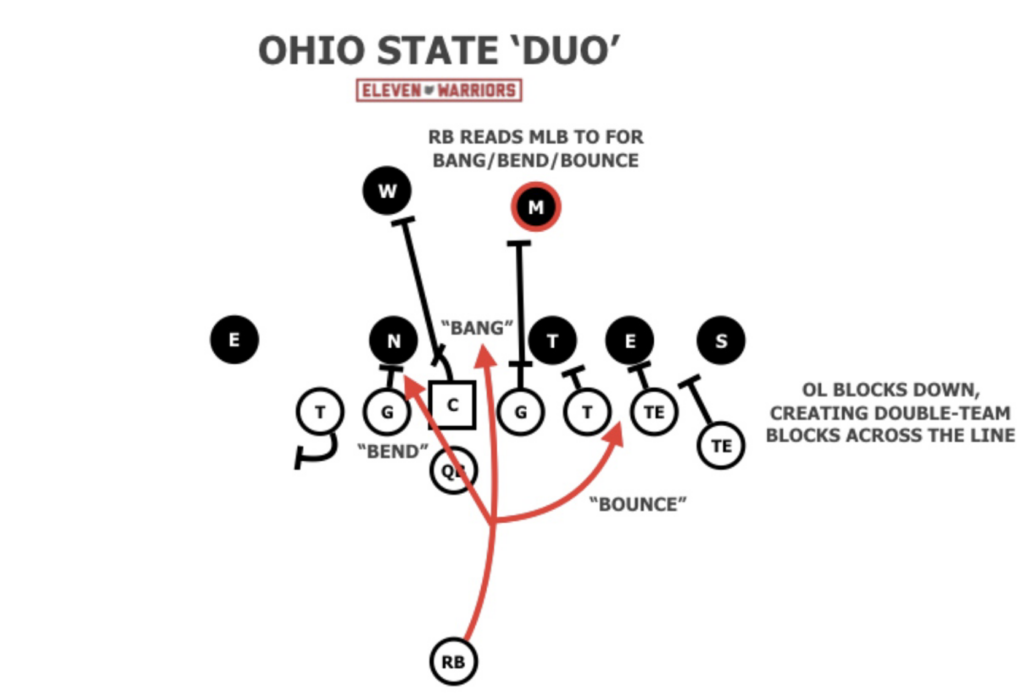
One key to distinguishing Duo from an inside zone run play is that Duo will generally be run to a 4-man surface (or a 5-man surface). “4/5-man surface” refers to the number of in-line blockers to a particular side of the center. See the following diagram below for a more visual explanation:

Another key to distinguishing Duo from Inside Zone when watching Ohio State is the fact that Ohio State almost exclusively runs Duo from under-center looks. As part of this, when running Duo, Ohio State’s quarterback will reverse pivot to hand the ball off. See the following clip:
Note how:
- Ohio State starts the play with a 4-man surface to the left of the center before motioning in a receiver in to create a 5-man surface.
- The entire line is down blocking the opposite direction of TreVeyon Henderson’s aiming point when he receives the handoff.
- C.J. Stroud reverse pivots after taking the snap to hand the ball off.
- Henderson bounces the run to the outside when he reads that the play-side inside linebacker is plugging the interior.
Motioning in a receiver to be an in-line blocker and create a bigger surface is something Ohio State often does when running Duo. Below, Ohio State starts with a 3-man surface to the left of the center before motioning in a receiver to create a 4-man surface:
However, Ohio State won’t always motion in a receiver when running Duo. Nonetheless, even when not motioning in a receiver, Ohio State still essentially exclusively runs Duo to at least a 4-man surface:
Furthermore, given that defenses across the country have moved towards a strategy of spilling interior run plays to the outside, the running back will often be forced to bounce the play outside when running Duo:
In 2022, Ohio State also added a new play to the run game known as “Windback”, which is essentially Duo with a little added wrinkle. See an example below:
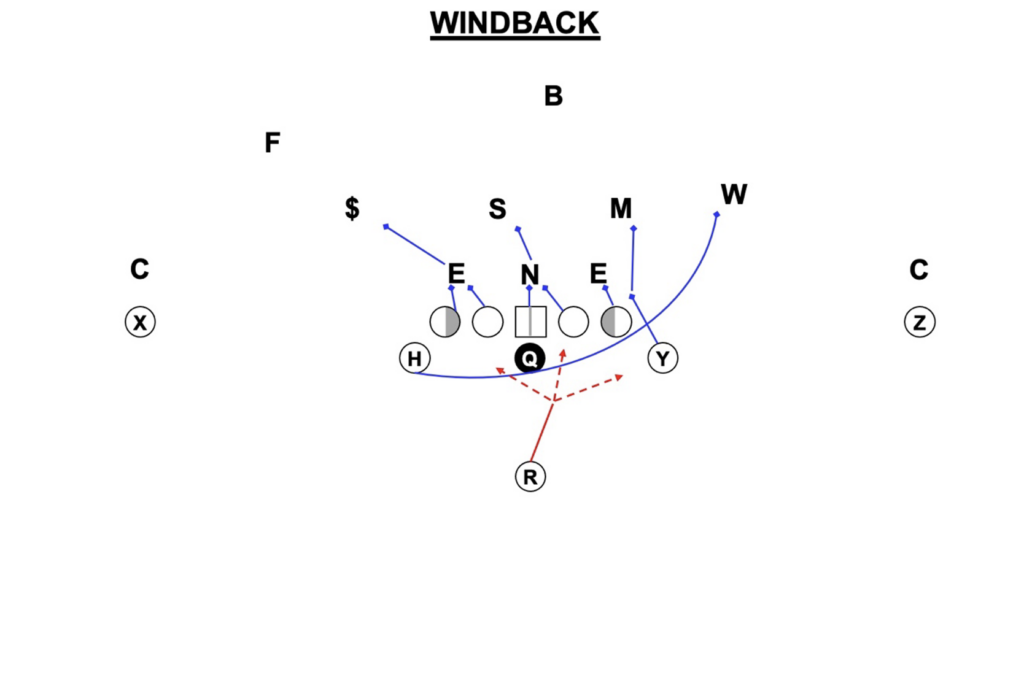
As you can see, Windback is blocked just like Duo – all of the offensive linemen and the play-side tight end are down blocking the opposite direction of the run to create double teams and pin the defense to the backside.
However, unlike Duo, Ohio State generally runs Windback to a 3-man surface rather than to a 4/5-man surface. Regardless, because of the backside receiver’s post-snap action of coming across the formation to become a lead blocker, it effectively becomes a 4-man surface after the snap.
While Ohio State runs Duo almost exclusively from under-center looks, Duo can be run from both shotgun and pistol looks as well. When a team runs Duo from shotgun, it can be even harder to distinguish it from an inside zone run play at first glance. Despite this, you can still distinguish Duo by focusing on the blocking scheme, the running back’s aiming point, and by recognizing that Duo will still generally be run to a 4/5-man surface even out of the shotgun.
Georgia, for example, almost exclusively runs Duo out of the shotgun, but it shouldn’t be confused with and inside zone run. See an example of Georgia running Duo from a shotgun look below:

As you can see, Georgia is running to a 5-man surface, the running back’s aiming point is to his right, and Georgia’s entire offensive line is down blocking the opposite direction.
CONCLUSION
The bottom line is that Duo technically isn’t a zone run scheme, despite not having any pulling offensive linemen. The entire offensive line is down blocking the opposite direction of the run’s aiming point and trying to pin the defense to the backside, which is what makes it a gap run scheme rather than a zone run scheme.
The running back will read the play-side linebacker to determine whether he should stay on an interior path or bounce the run outside.
While Ohio State almost solely runs Duo from under-center formations, Duo can be run from shotgun looks as well.




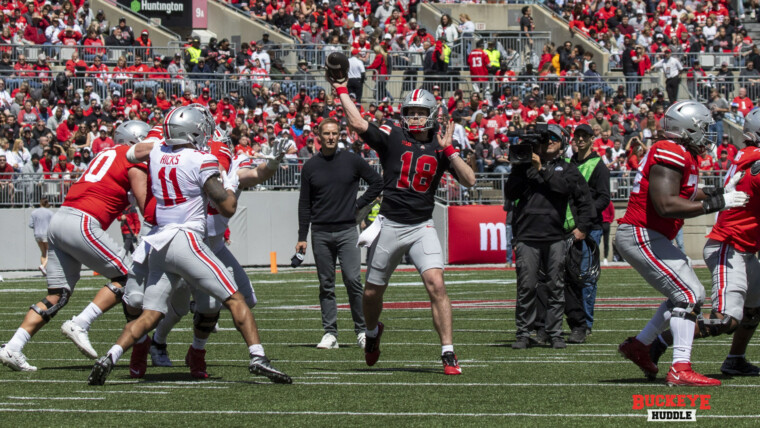
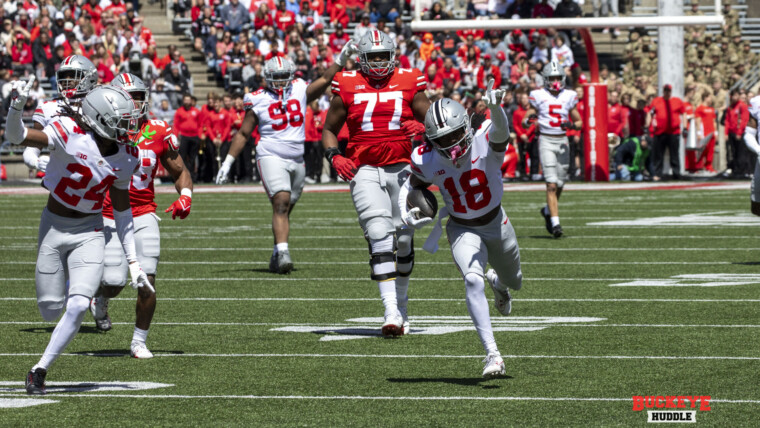

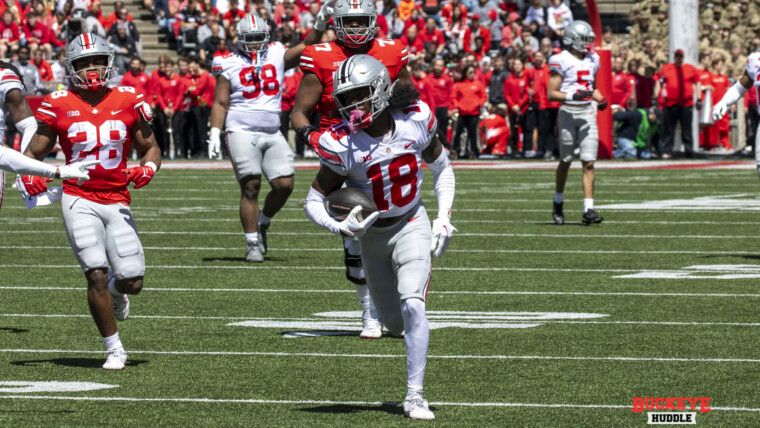
Denzel Burke Seeing More And More To Like From Will Howard
Sherrone Moore On Playing Ohio State Multiple Times This Year: ‘Love It. Yes. Let’s Do It’
Ryan Day’s Message For The Michigan Game This Year? ‘Leave No Doubt’
Closer Look: James Peoples Ready For Significant Role This Year?
Big Ten Bluebloods Being Challenged By Oregon
Ryan Day Expecting A Number Of True Freshmen Buckeyes To Play This Year
Sherrone Moore On Playing Ohio State Multiple Times This Year: ‘Love It. Yes. Let’s Do It’
Archie Griffin To Dot The i In Buckeyes’ Season Opener